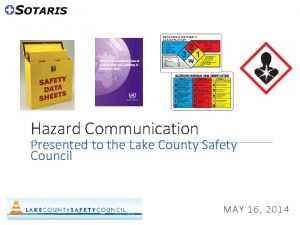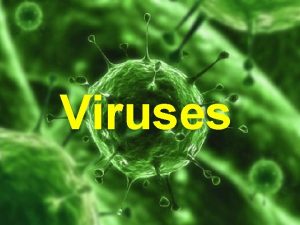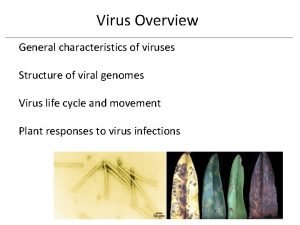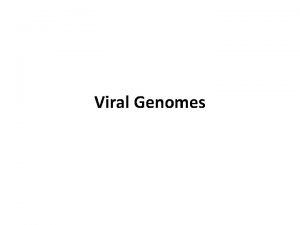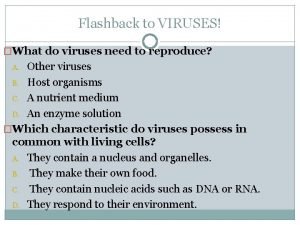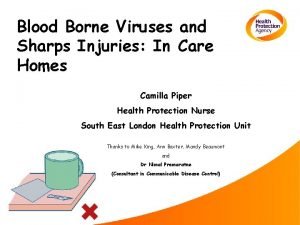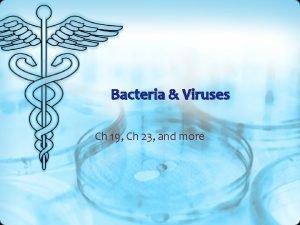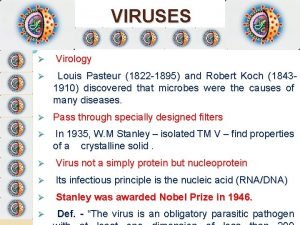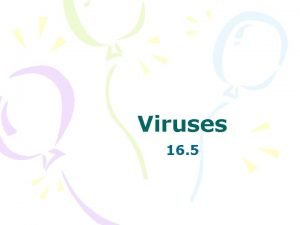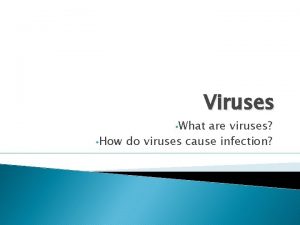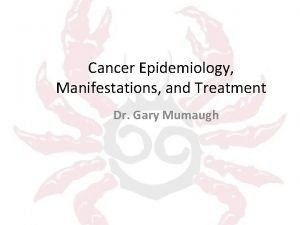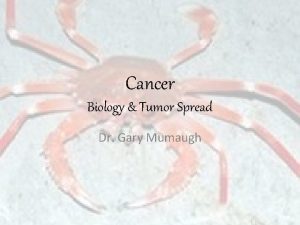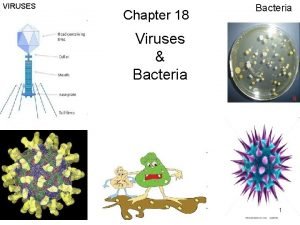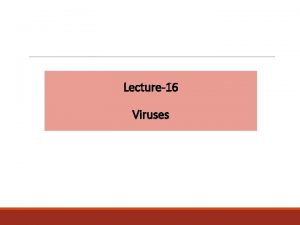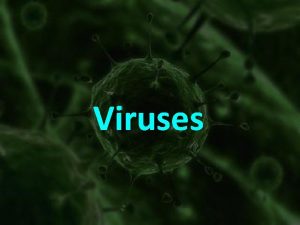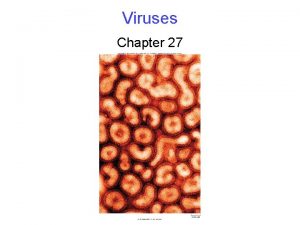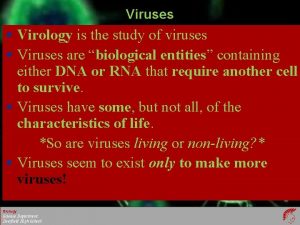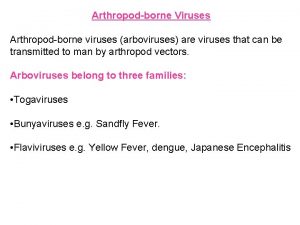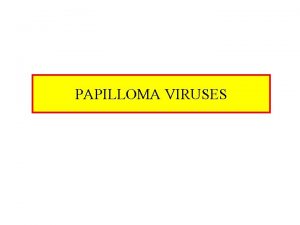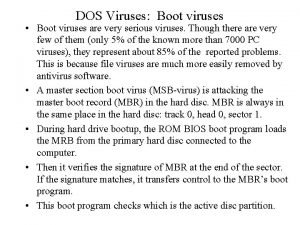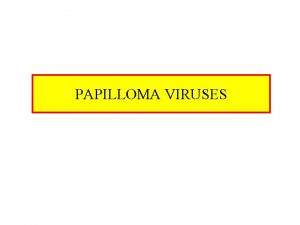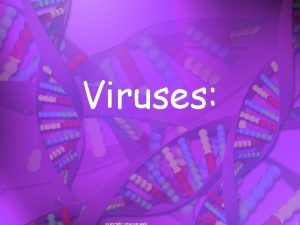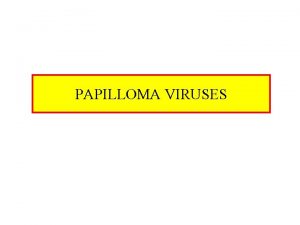Viruses That Can Cause Cancer Dr Gary Mumaugh

































- Slides: 33

Viruses That Can Cause Cancer Dr. Gary Mumaugh Bethel University

• Viruses are very small organisms; most can’t even be seen with an ordinary microscope. They are made up of a small number of genes in the form of DNA or RNA surrounded by a protein coating. • A virus must enter a living cell and “hijack” the cell’s machinery in order to reproduce and make more viruses. • Some viruses do this by inserting their own DNA (or RNA) into that of the host cell. When the DNA or RNA affects the host cell’s genes, it can push the cell toward becoming cancer.

• In general, each type of virus tends to infect only a certain type of cell in the body. (For example, the viruses that cause the common cold only infect the cells lining the nose and throat. ) • Several viruses are linked with cancer in humans. Our growing knowledge of the role of viruses as a cause of cancer has led to the development of vaccines to help prevent certain human cancers. • But these vaccines can only protect against infections if they are given before the person is exposed to the cancer-promoting virus.

Viruses • Viruses are a means of transmitting genetic information in an effort to continue their survival • In order to accomplish their end goal, viruses act as agents which reproduce their own DNA/RNA within living cells

How a virus can spread Influenza virus

Human Papilloma Viruses (HPVs) • Human papilloma viruses (HPVs) are a group of more than 150 related viruses. • They are called papilloma viruses because some of them cause papillomas, which are more commonly known as warts. • Some types of HPV only grow in skin, while others grow in mucous membranes such as the mouth, throat, or vagina. • All types of HPV are spread by contact (touch). • More than 40 types of HPV can be passed on through sexual contact. • Most sexually active people are infected with one or more of these HPV types at some point in their lives.

• At least a dozen of these types are known to cause cancer. • While HPV infections are very common, cancer caused by HPV is not. • Most people infected with HPV will not develop a cancer related to the infection. • HPV infections of the mucous membranes can cause genital warts, but they usually have no symptoms. • There are no effective medicines or other treatments for HPV, other than removing or destroying cells that are known to be infected. • But in most people, the body’s immune system controls the HPV infection or gets rid of it over time.

HPV and Cervical Cancer • HPVs also have a role in causing some cancers of the penis, anus, vagina, and vulva. • They are linked to some cancers of the mouth and throat, too. • Although HPVs have been linked to these cancers, most people infected with HPV never develop these cancers. • Smoking, which is also linked with these cancers, may work with HPV to increase cancer risk. Other genital infections may also increase the risk that HPV will cause cancer. • HPV

Vaccines Against HPV • Vaccines are now available to help protect against infection from the main cancer-causing HPV types. • These vaccines are approved for use in females from age 9 up to their mid-20’s. • Some HPV vaccines have also been approved for use in boys and young men. • The vaccines can only be used to help prevent HPV infection – they do not stop or help treat an existing infection. • To be most effective, the vaccines should be given before a person becomes sexually active (has sex with another person).

• Because the vaccines are still fairly new (first approved in 2006), and it often takes decades for cancer to develop, it’s not yet known how well they will protect against it, or exactly which types of cancers they might help prevent. • These vaccines and others like them are being studied further.


Epstein-Barr Virus (EBV) • EBV is a type of herpes virus. • It is probably best known for causing infectious mononucleosis, often called “mono” or the “kissing disease. ” • In addition to kissing, EBV can be passed from person to person by coughing, sneezing, or by sharing drinking or eating utensils. • Most people in the United States are infected with EBV by the end of their teen years, although not everyone develops the symptoms of mono.

• As with other herpes virus infections, EBV infection is life-long, even though most people have no symptoms after the first few weeks. • EBV infects and stays in certain white blood cells in the body called B lymphocytes (also called Bcells). • There are no medicines or other treatments to get rid of EBV, nor are there vaccines to help prevent it, but EBV infection doesn’t cause serious problems in most people.

• EBV infection increases a person’s risk of getting nasopharyngeal cancer and certain types of fast-growing lymphomas such as Burkitt lymphoma. • It may also be linked to Hodgkin lymphoma and some cases of stomach cancer. • EBV-related cancers are more common in Africa and parts of Southeast Asia. • Overall, very few people who have been infected with EBV will ever develop these cancers.


Hepatitis B Virus (HBV) and Hepatitis C Virus (HCV) • Both HBV and HCV cause viral hepatitis, a type of liver infection. • Other viruses can also cause hepatitis (hepatitis A virus, for example), but only HBV and HCV can cause the long-term (chronic) infections that increase a person’s chance of liver cancer. • In the United States, less than half of liver cancers are linked to HBV or HCV infection. • But this number is much higher in some other countries, where both viral hepatitis and liver cancer are much more common

• Some research also suggests that long-term HCV infection might be linked with some other cancers, such as non-Hodgkin lymphoma. • HBV and HCV are spread from person to person in much the same way as HIV - through sharing needles, unprotected sex, or childbirth. • They can also be passed on through blood transfusions, but this is rare in the United States because donated blood is tested for these viruses.

• Of the 2 viruses, infection with HBV is more likely to cause symptoms, such as a flu-like illness and jaundice. • Most adults recover completely from HBV infection within a few months. • Only a very small portion of adults go on to have chronic HBV infections, but this risk is higher in young children. • People with chronic HBV infections have a higher risk for liver cancer.



• HCV is less likely to cause symptoms than HBV, but it is more likely to cause chronic infection, which can to lead to liver damage or even cancer. • An estimated 3. 2 million people in the United States have chronic HCV infection, and most of these people don’t even know they have it. • CDC recommends that all people born between 1945 and 1965 (as well as some other people at high risk) get blood tests to check for HCV.

• Once an infection is found, treatment and preventive measures can be used to slow liver damage and reduce cancer risk. • Both hepatitis B and C infections can be treated with drugs. • Treating chronic hepatitis C infection with a combination of drugs for at least a few months can get rid of HCV in many people. • A number of drugs can also be used to help treat chronic hepatitis B. • Although they don’t cure the disease, they can lower the risk of liver damage and might lower the risk of liver cancer as well.

• There is a vaccine to prevent HBV infection, but none for HCV. • In the United States, the HBV vaccine is recommended for all children. • It’s also recommended for adults who are at risk of exposure. • This includes people infected with HIV, homosexuals, IV drug users, people in certain group homes, people with certain medical conditions and occupations (such as health care workers).


Human Immunodeficiency Virus (HIV) • HIV, the virus that causes acquired immune deficiency syndrome (AIDS), doesn’t appear to cause cancers directly. • But HIV infection increases a person’s risk of getting several types of cancer, especially some linked to other viruses. • HIV can be spread through semen, vaginal fluids, blood, and breast milk from an HIV-infected person.

Known routes of spread include: • Unprotected sex with an HIV-infected person • Injections with needles or • Exposure of infants from mothers with HIV • Breastfeeding by mothers with HIV • Transfusion of blood products containing HIV • The risk of HIV from a transfusion is less than 1 in a million in the United States due to blood testing and donor screening • Organ transplants from an HIV-infected person • Penetrating injuries or accidents (usually needle sticks) in health care workers while caring for HIV-infected patients or handling their blood

• HIV is not spread by insects, through water, or by casual contact such as talking, shaking hands, hugging, coughing, sneezing, or from sharing dishes, bathrooms, kitchens, phones, or computers. • It is not spread through saliva, tears, or sweat. • HIV infects and destroys white blood cells known as helper Tcells, which weakens the body’s immune system. • This might let some other viruses, such as HPV, thrive, which might lead to cancer. • The immune system is also important in attacking and destroying newly formed cancer cells. • A weak immune system might let new cancer cells survive long enough to grow into a serious, life-threatening tumor.

• Because HIV infection often has no symptoms for years, a person can have HIV for a long time and not know it. • The CDC recommends that everyone between the ages of 13 and 64 be tested for HIV at least once as part of their routine health care. • There is no vaccine to prevent HIV. • But there are ways to lower your risk of getting it, such as not having unprotected sex or sharing needles with someone who has HIV.



Human Herpes Virus 8 (HHV-8) • HHV-8, also known as Kaposi sarcoma–associated herpes virus (KSHV), has been found in nearly all tumors in patients with Kaposi sarcoma (KS). • KS is a rare, slow-growing cancer that often appears as reddishpurple or blue-brown tumors just underneath the skin. • In KS, the cells that line blood and lymph vessels are infected with HHV-8. • HHV-8 is transmitted through sex and appears to be spread other ways, such as through blood and saliva, as well.

• HHV-8 infection is life-long (as with other herpes viruses), but it does not appear to cause disease in most healthy people. • Almost all people who develop KS have other conditions that have weakened their immune system, such as HIV infection or immune suppression after an organ transplant. • KS was rare in the United States until it started appearing in people with AIDS in the early 1980 s. • The number of people with KS has dropped in the US since peaking in the early 1990 s, most likely because of better treatment of HIV infection.

Kaposi Sarcoma in Aids
 Lytic cycle animation
Lytic cycle animation Watch?v=dhlvcdeg0yg
Watch?v=dhlvcdeg0yg Phân độ lown ngoại tâm thu
Phân độ lown ngoại tâm thu Block xoang nhĩ ecg
Block xoang nhĩ ecg Thể thơ truyền thống
Thể thơ truyền thống Thơ thất ngôn tứ tuyệt đường luật
Thơ thất ngôn tứ tuyệt đường luật Walmart thất bại ở nhật
Walmart thất bại ở nhật Tìm vết của mặt phẳng
Tìm vết của mặt phẳng Hãy nói thật ít để làm được nhiều
Hãy nói thật ít để làm được nhiều Tôn thất thuyết là ai
Tôn thất thuyết là ai Gây tê cơ vuông thắt lưng
Gây tê cơ vuông thắt lưng Sau thất bại ở hồ điển triệt
Sau thất bại ở hồ điển triệt Flame over circle symbol meaning
Flame over circle symbol meaning Ter thin client
Ter thin client Ultimate cause of behavior
Ultimate cause of behavior Proximate vs ultimate causation
Proximate vs ultimate causation Imprinting examples in animals
Imprinting examples in animals Why are viruses considered nonliving?
Why are viruses considered nonliving? Bacteriophage characteristics
Bacteriophage characteristics General characteristics of viruses
General characteristics of viruses Viruses
Viruses Lysogenic viruses do not
Lysogenic viruses do not Section 19-3 diseases caused by bacteria and viruses
Section 19-3 diseases caused by bacteria and viruses Cultivation of viruses
Cultivation of viruses Cultivation of viruses
Cultivation of viruses Egrette - chapter 21
Egrette - chapter 21 Nonliving particle that replicates inside a living cell
Nonliving particle that replicates inside a living cell Blood borne viruses
Blood borne viruses What are viruses lesson 3
What are viruses lesson 3 Are viruses alive yes or no
Are viruses alive yes or no Animal virus
Animal virus Why are viruses considered nonliving
Why are viruses considered nonliving General characters of viruses
General characters of viruses Helical virus
Helical virus












